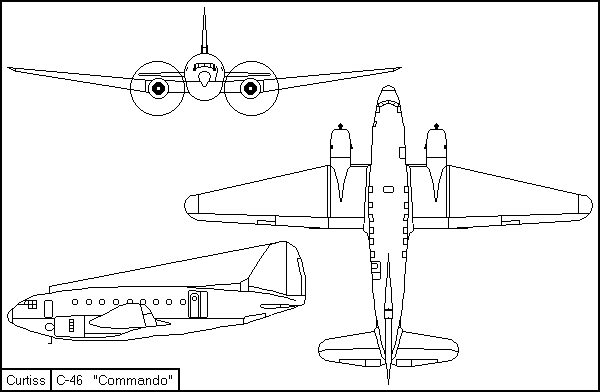 | CURTISS C-46 "COMMANDO" |  |
 | CURTISS C-46 "COMMANDO" |  |

| MANUFACTURER | USAAF DESIGNATION | WING SPAN | LENGTH | POWER | ARMAMENT |
| Curtiss-Wright | C-46 | 108' 1" | 76'4" | 2 P&W R-2800-51 2000Hp ea | None |
| EMPTY WEIGHT (Lbs) |
GROSS WEIGHT (Lbs) |
TOP SPEED (Mph) |
CRUISING SPEED (Mph) |
RANGE (Miles) |
SERVICE CEILING (Feet) |
| 32,400 | 56,000 | 269 | 183 | 1,200 | 27,600 |
The C-46 "Commando" was based on the CW-20 commercial airliner first flown on in March, 1940. The CW-20 was concieved as a competitor to the Douglas DC-3, and was to have advanced features such as a pressureized cabin. With a wing span of 108 feet (only two feet shorter than the Consolidated B-24 "Liberator" bomber), it was the largest twin engine transport used by the USAAF. It's sheer size and power allowed it to carry a far greater load than could the more famous C-47, a fact not lost on the USAAF's Air Transport and Troop Carrier commands, which accepted 3,144 "Commandos" for hauling cargo, and personnel, and for towing gliders. The C-46 saw its greatest use in the CBI flying the infamous "Hump" route between India and China. Its ability to fly higher, faster and farther while carrying a greater load gained it its fame. Unfortunately, the treacherous weather encountered while flying "The Hump", coupled with maintenance problems associated with its advanced design, resulted in a relatively heavy loss rate, giving the C-46 a reputation as a dangerous ship to fly. The huge size of the aircraft, along with its somewhat unusual feselage shape gained it the nick name of "The Whale" for its resemblance to a whale. Maintenance crews, gave it the less affectionate nicname "Plumber's Nightmare" due to the complexity of the hydraulic systems that operated the control surfaces as well as brakes and landing gear.
Aircraft |
Links |
Library |
Sections |
Units |